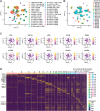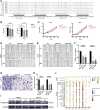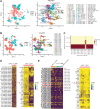Integrative Single-Cell Analysis Reveals Transcriptional and Epigenetic Regulatory Features of Clear Cell Renal Cell Carcinoma
- PMID: 36607615
- PMCID: PMC9978887
- DOI: 10.1158/0008-5472.CAN-22-2224
Integrative Single-Cell Analysis Reveals Transcriptional and Epigenetic Regulatory Features of Clear Cell Renal Cell Carcinoma
Abstract
Clear cell renal cell carcinoma (ccRCC) frequently features a high level of tumor heterogeneity. Elucidating the chromatin landscape of ccRCC at the single-cell level could provide a deeper understanding of the functional states and regulatory dynamics underlying the disease. Here, we performed single-cell RNA sequencing (scRNA-seq) and single-cell assay for transposase-accessible chromatin using sequencing (scATAC-seq) on 19 ccRCC samples, and whole-exome sequencing was used to understand the heterogeneity between individuals. Single-cell transcriptome and chromatin accessibility maps of ccRCC were constructed to reveal the regulatory characteristics of different tumor cell subtypes in ccRCC. Two long noncoding RNAs (RP11-661C8.2 and CTB-164N12.1) were identified that promoted the invasion and migration of ccRCC, which was validated with in vitro experiments. Taken together, this study comprehensively characterized the gene expression and DNA regulation landscape of ccRCC, which could provide new insights into the biology and treatment of ccRCC.
Significance: A comprehensive analysis of gene expression and DNA regulation in ccRCC using scATAC-seq and scRNA-seq reveals the DNA regulatory programs of ccRCC at the single-cell level.
©2023 The Authors; Published by the American Association for Cancer Research.
Figures








References
-
- Sung H, Ferlay J, Siegel RL, Laversanne M, Soerjomataram I, Jemal A, et al. . Global cancer statistics 2020: GLOBOCAN estimates of incidence and mortality worldwide for 36 cancers in 185 countries. CA Cancer J Clin 2021;71:209–49. - PubMed
-
- Xu W, Atkins MB, McDermott DF. Checkpoint inhibitor immunotherapy in kidney cancer. Nat Rev Urol 2020;17:137–50. - PubMed
-
- Motzer RJ, Hutson TE, Tomczak P, Michaelson MD, Bukowski RM, Rixe O, et al. . Sunitinib versus interferon alfa in metastatic renal-cell carcinoma. N Engl J Med 2007;356:115–24. - PubMed
Publication types
MeSH terms
Substances
LinkOut - more resources
Full Text Sources
Medical
Molecular Biology Databases

